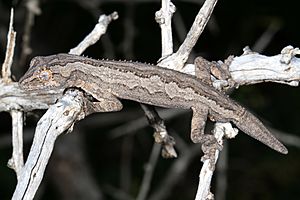Strophurus intermedius facts for kids
Quick facts for kids Strophurus intermedius |
|
|---|---|
 |
|
| Conservation status | |
| Scientific classification | |
| Genus: |
Strophurus
|
| Species: |
intermedius
|
The southern spiny-tailed gecko (scientific name: Strophurus intermedius) is a cool type of lizard. It's also sometimes called the eastern spiny-tailed gecko. This gecko lives only in the dry, sunny parts of Australia. You can find it in places like New South Wales, the Northern Territory, South Australia, Victoria, and Western Australia. It likes to live in areas with mallee shrubs and woodlands.
Contents
What Does It Look Like?
The southern spiny-tailed gecko is one of the bigger geckos in Australia. Its body is grey with cool patterns, and its belly is light-coloured. It got its name from the two rows of spiky bumps along its back and tail. These spikes are orange-brown and get even spikier towards the tail.
These spikes are super important for its safety! If an attacker comes too close, the gecko can squirt a harmless but smelly orange liquid from its tail spikes. This helps scare away predators.
This gecko has strong legs and body. Its toes have special disc-like tips, just like many other geckos. Inside its mouth, it has a blue lining, and its eyes have a bright orange ring around the iris.
Its head is shaped like an oval and is rounded, with a blunt nose and big eyes. There are no spikes above its eyes. Adult geckos are about 64 millimeters (about 2.5 inches) long from their snout to the start of their tail. Female geckos are usually bigger than males. Males also have noticeable bumps near their tail, which females do not.
Where It Got Its Name
A scientist named James Douglas Ogilby first described the southern spiny-tailed gecko in 1892. He gave it the scientific name Diplodactylus intermedius back then.
The group of geckos called Strophurus has 20 different types, and all of them live only in Australia. Most geckos in this group have spikes along their back and tail. They all share that special defense trick of squirting smelly liquid from their tails. The name Strophurus means "turning tail" in Latin, and intermedius means "intermediate."
Where Does It Live?
You can find the southern spiny-tailed gecko in the southern parts of the Northern Territory, Western Australia, and Queensland. It lives all across New South Wales and South Australia, and in the northern half of Victoria. It's often seen around Alice Springs in the Northern Territory.
Home and Habits
The southern spiny-tailed gecko is a nocturnal animal, meaning it's active at night. It lives on the land and is an ectotherm, which means its body temperature depends on its surroundings. That's why it likes warm, dry places!
During the day, it hides under rocks, tree bark, or inside logs to stay cool and safe. It also likes to hide in Spinifex grass. At night, it comes out to hunt for food. You'll usually find it in areas with shrubs, woodlands, and grasslands.
Life Cycle
Southern spiny-tailed geckos lay eggs. This is called being oviparous. Females start laying eggs when they are about two years old. During the summer, a female will lay a clutch of two eggs. It takes about 45 days for the eggs to hatch. Females can lay eggs for about six months of the year. Both male and female geckos become adults when they are two years old.
What's on the Menu?
The southern spiny-tailed gecko eats only arthropods. These are creatures with exoskeletons, like spiders, centipedes, scorpions, cockroaches, crickets, and beetles (and their larvae). Its diet is very similar to that of its relative, S. spinigerus.
Who Are Its Enemies?
The smelly liquid that the southern spiny-tailed gecko sprays from its tail is mainly aimed at birds that try to attack it. However, this gecko can also face danger from animals that are not native to Australia, like feral cats. In central Australia, feral cats are known to eat many different animals, including reptiles like geckos. It seems that during the summer, feral cats often hunt and eat reptiles.
Is It Safe?
Good news! The southern spiny-tailed gecko is not a threatened species. The IUCN Red List of Threatened Species has looked at this gecko and decided it is of "Least Concern." This means there are plenty of them around, and they are not in danger of disappearing.


